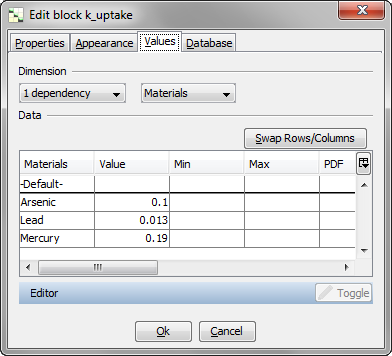tutorial_2-assigning_material_dependent_values
Tutorial 2 - Assigning material dependent values
5/7
This lesson will teach you how to vectorize parameters, of Index lists and how to assign index-specific data.
The two parameters of the model control the uptake rate and the excretion rate of the fish. These coefficients are typically substance dependent.
Converting a parameter to a vector
- Open the Blocks window by selecting Window | Blocks from the menu bar.
- Right-click the k_uptake parameter and select Edit from the pop-up menu.
- Select the Values tab.
- From the Dimension drop-down list, select “1 dependency”. Make sure that “Materials” is selected in the drop-down list that appears.
- As you see, the table now has a row for each material. The top row can be used for default values. If no value is specified for a material, the default value is used.
- Assign the following values to the k_uptake parameter:
| Material | Value |
|---|---|
| Arsenic | 0.1 |
| Lead | 0.013 |
| Mercury | 0.19 |
Assigning values to k_excretion
Follow the same procedure as above, and assign the following values to k_excretion:
| Material | Value |
|---|---|
| Arsenic | 0.05 |
| Lead | 0.003 |
| Mercury | 0.01 |
Assigning initial conditions
Ecolego will automatically convert all compartments to vectors when materials are added to the model.
- Select the Values tab. As the compartment is a vector, you must now assign initial inventories of all material:
| Material | Value |
|---|---|
| Arsenic | 10000 |
| Lead | 10 |
| Mercury | 1000 |
Next
Previous
References
tutorial_2-assigning_material_dependent_values.txt · Last modified: 2023/03/15 11:54 by dmytroh


